Volcanoes Both Cool and Warm Earth's Climate
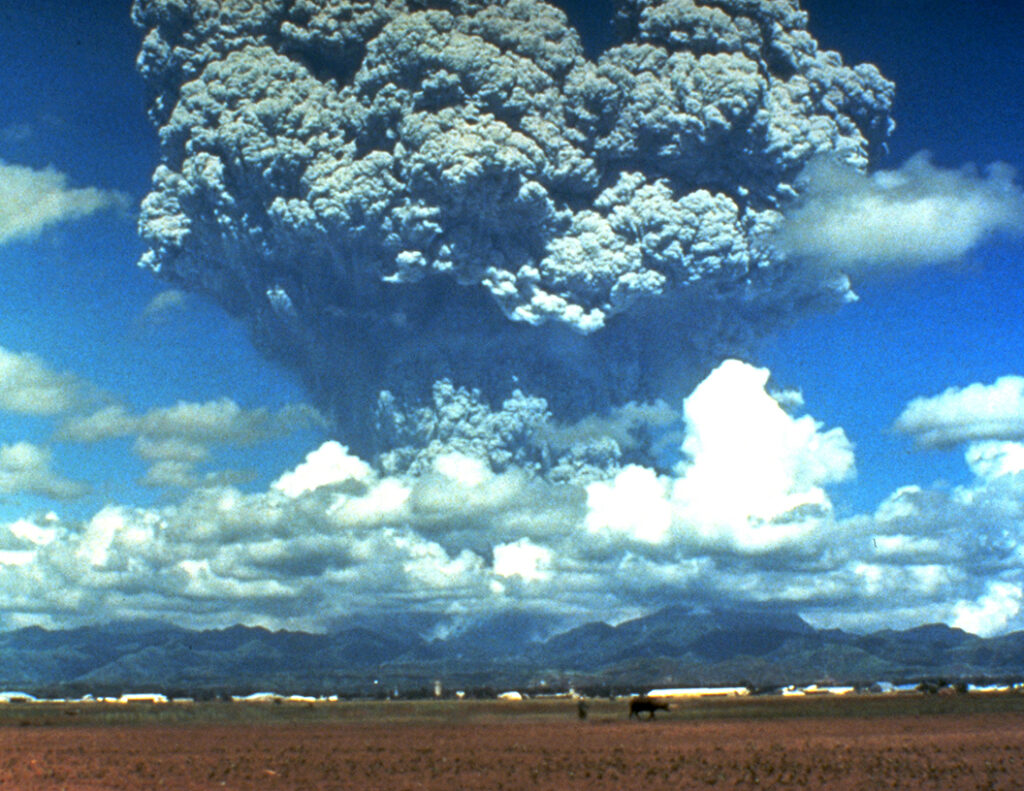
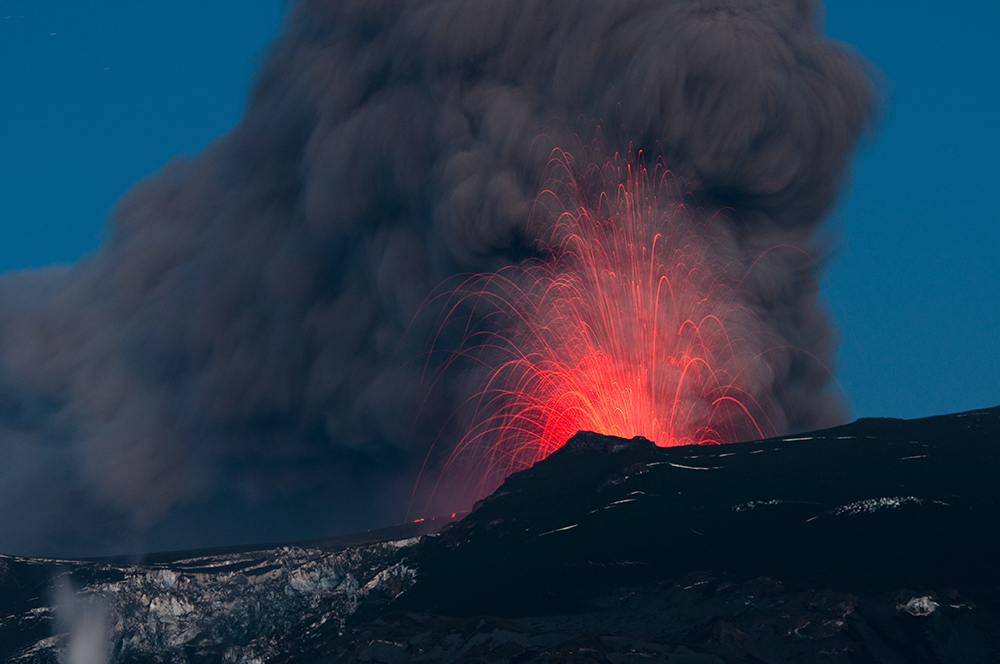
Explosive volcanic eruptions cool Earth
On June 15, 1991, Pinatubo volcano in the Philippines (15oN, 120oE) erupted ~5 km3 of dacitic magma primarily within 9 hours, ejecting 17±2 Mt (megatons) of sulfur dioxide (SO2) as much as at least 35 km into the stratosphere with peak mixing ratios observed via the SAGE II satellite of 300 ppbm (parts per billion by mass) decreasing to 160 ppbm within 180 days, and remaining above background for two years (Self et al., 1996). Within 21 days, SO2 injected into the lower stratosphere had circled Earth and spread poleward to 30°N and 10°S. Within one year the SO2 had spread throughout the globe. Approximately 13 Mt of erupted SO2 (Self et al., 1996) ultimately was oxidized to form a nominally 75% sulfuric acid and 25% water aerosol primarily at altitudes between 20 and 25 km (McCormick and Veiga, 1992) with an e-folding time of aerosol formation in the tropics of ~35 days (Bluth et al., 1992) but as much as 13 months in the Arctic (Stone et al., 1993). The mid-visible (green, ~500 nanometers) optical depth of the atmosphere increased to 0.3 within 2 months, peaked at 0.4 by late 1992, and averaged globally 0.1 to 0.15 for 2 years, thought to decrease solar radiation at Earth’s surface by ~2.7 W/m2 in August and 2.5 W/m2 by late 1991 (Self et al., 1996). Surface temperatures decreased up to 0.6oC lower than normal in the northern hemisphere and averaged 0.4oC lower than normal over most of the globe through 1993. However during the winters of 1991 and 1992, surface temperatures increased as much as 3°C above normal over North America, Europe, and Siberia (Robock, 2002). The lower stratosphere warmed as much as 3oC by mid-November, 1991, but cooled to 0.35oC below pre-eruptive levels by early 1993 (Labitzke and McCormick, 1992) (Thompson and Solomon, 2009).
Most explosive volcanic eruptions of evolved magmas, such as andesite, dacite, and rhyolite, eject megatons of SO2 within hours into the stratosphere, where, over weeks to months, the SO2 gas is oxidized to form sulfuric acid vapor that coalesces onto condensation nuclei forming aerosols with particle sizes dominantly in the range of 300 to 500 nanometers (Deshler et al., 1993) (Asano, 1993), large enough to reflect and disperse solar radiation causing global cooling of 0.3 to 0.6oC for up to 3 years (Robock, 2000) (Self, 2006). Formation of these aerosols takes time and depends on the photochemistry and stratified nature of the lower stratosphere. SO2 in the more turbulent troposphere will not form aerosols that reflect sunlight as efficiently.
But effusive volcanic eruptions warm Earth
Extrusive eruptions of primitive basaltic magma, on the other hand, extrude extensive lava flows for days, months, centuries, and even hundreds-of-thousands of years, emit 10 to 100 times more volatiles per cubic kilometer of magma (Palais and Sigurdsson, 1989) (Freda et al., 2005) (Self et al., 2008), do not eject most of these emissions high enough to reach the stratosphere, do not form extensive stratospheric aerosols, and cause net warming. The two largest in history were in South Iceland in the vicinity of the intersection of a developing east-west transform fault and the main spreading center of the mid-Atlantic Ridge (Ward, 1971): Eldgjá, erupting 18 km3 of basalt from 934 to 940 (Hjartarson, 2011), and Laki, erupting 15.1 km3 from June 8, 1783, to February 7, 1784 (Thordarson and Self, 2003). Laki ejected ~24 Mt of SO2 into the lower stratosphere but an additional ~96 Mt SO2 into the troposphere where the jet stream carried much of it to the southeast toward Europe (Kington, 2009) (Thordarson and Self, 2003). Severe acid damage to vegetation from Iceland to Eastern Europe, to Italy suggests concentrations of SO2 could have been as high as 1000 parts per billion (ppb) (Thordarson and Self, 2003), at least three orders of magnitude larger than the background.
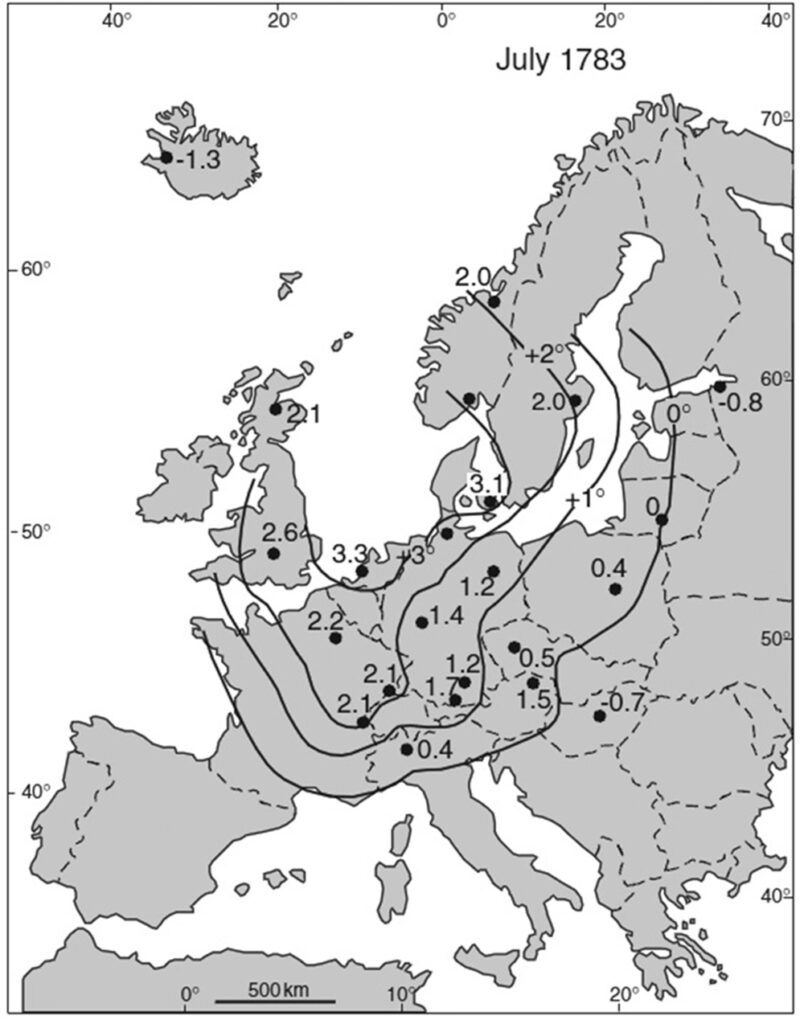
A “dry fog” blanketed much of Europe primarily from mid-June through August, 1783. SO2 is invisible but when absorbing ultraviolet radiation, the electronic transitions cause fluorescence in the visible spectrum explaining the appearance of “dry fog.” There were ten major eruptive phases from June thru October. In July, surface temperatures in western Europe increased as much as 3.3oC above the 30-year mean centered on 1783 (Thordarson and Self, 2003) and temperatures in Central England were the highest recorded from the first measurements in 1659 (Manley, 1974) until 1983 (Parker et al., 1992). SO2 injected into the stratosphere would not have had adequate time to form aerosols during the many eruptive phases in July.
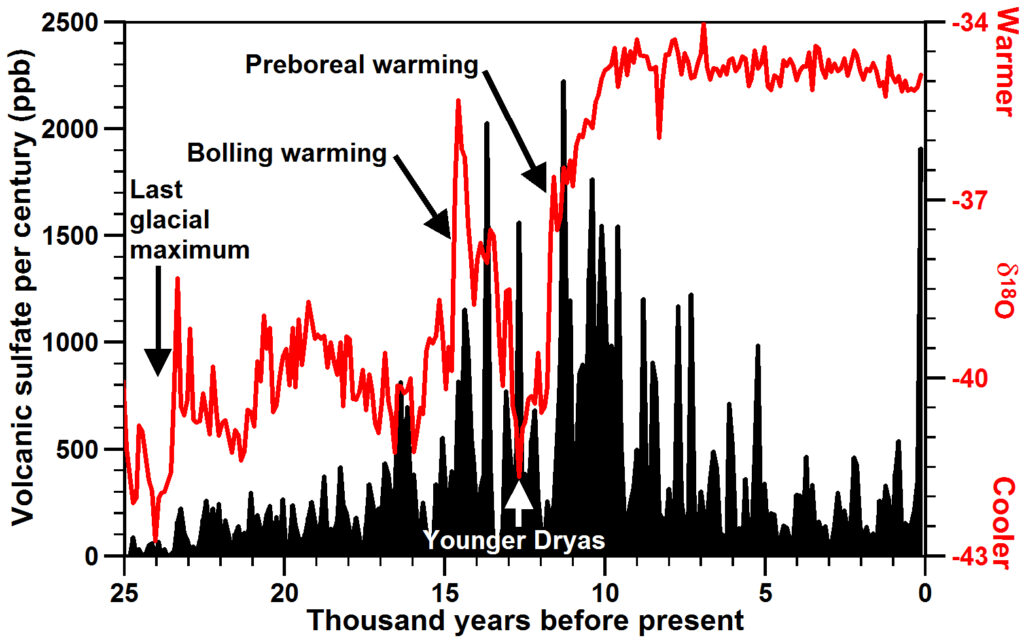
The Laki eruption deposited ~115 ppb sulfate in snow at Summit Greenland, 1500 km to the west-northwest (Zielinski et al., 1996). Only 1.4% of the GISP2 ice layers measured representing the past 25,000 years contain more sulfate. The total sulfate deposited during the 18th century was only 217 ppb. The layers of ice in the GISP2 borehole that contain the largest concentrations of volcanic sulfate per century (black) also contain (δ18O) evidence (White et al., 1997) for the most rapid global warming (red) during the Bølling warming, decreasing during the cooler Younger Dryas, and increasing again during the Preboreal warming. Volcanic sulfate is total sulfate measured minus the small contributions from sea salt and dust determined by sodium and calcium content (Mayewski et al., 1997). Depletion of hydrogen peroxide (H2O2) associated with volcanic sulfate deposits in snow suggests that the SO2 reached Greenland as a gas and was oxidized to sulfate during precipitation (Laj et al., 1990).
The temporal association of SO2 emissions with warming at least in the Greenland region over the past 25,000 years shown in this figure is unambiguous. There is little error in relative timing between sulfate and the δ18O proxy for temperature because both are measured in the same layers of ice. The ratio of signal to noise is very high. Peak sulfate per century during peak warming (2028 ppb) is 218 times greater than average sulfate per century (9.3 ppb) during the last glacial maximum (25,000 to 21,000 years before present) and 441 times greater than average sulfate (4.6 ppb) between 5000 and 1000 years before present. More than 63% of the 7000 ice layers measured contain zero volcanic sulfate. In 2009, I tried to explain how the warming might be caused by SO2 (Ward, 2009) (Ward, 2010) but ultimately realized that sulfate and its precursor (SO2) simply indicate the rate of volcanism per century and the likely amount of associated ozone depletion discussed later.
Basaltic volcanism under ice forms long, flat-topped, steep-sided table mountains or tuyas found throughout Iceland. “12 of the 13 dated table mountains experienced their final eruptive phase during the last deglaciation” (Licciardi et al., 2007). Melting of ice might have increased magma production by decreasing the vertical loading on the top of the magma sources (Huybers and Langmuir, 2009). The relatively continuous high rate of most-likely basaltic volcanism from 11,700 to 9800 years before present, possibly assisted by increases in solar radiation due to Milanković cycles, was apparently sufficient to warm the ocean, and thus Earth, out of the last ice age.
Volcanism was similarly highest, primarily in Iceland, during the other 13 Dansgaard-Oeschger sudden warmings between 46,000 and 11,600 thousand years before present (Rahmstorf, 2003) (Severinghaus, 1999). During these sudden warmings, regional surface temperatures rose to inter-glacial levels within a decade or two and then decreased back to ice-age temperatures over decades to centuries most likely as volcanism waned before the deep ocean could be warmed (Ward, 2009) discussed in detail in Abrupt Climate Change.
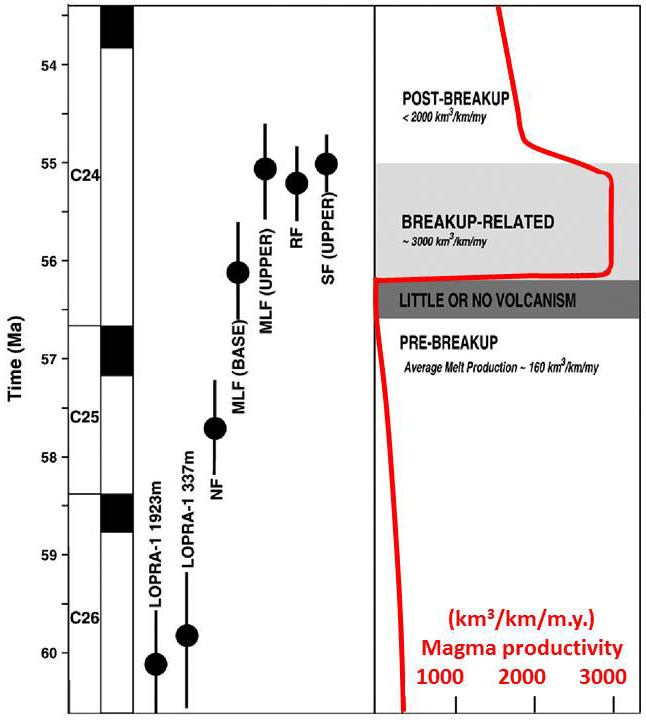
The Paleocene-Eocene Thermal Maximum (PETM) was a brief period of extreme global warming beginning around 56.1 Ma (million years before present) as subaerial extrusion of basalts related to the opening of the Greenland–Norwegian Sea suddenly increased to rates greater than 3000 km3 per kilometer of rift per million years (Storey et al., 2007) although basalt extrusion may have lasted only 220,000 years (Röhl et al., 2000). Global surface temperatures rose 5 to 9oC within a few thousand years (Zeebe et al., 2009). Sea surface temperatures near the North Pole increased to 23oC (Sluijs et al., 2006). Southwest Pacific sea surface temperatures rose rapidly to 34oC, cooling back to 21oC over seven million years (Bijl et al., 2009).
The Laki eruption in 1783 extruded 12.3 km3 of lava flowing over an area of 565 km2. Every 6 to 52 million years, 22 on average, there have been massive eruptions of 0.2 to 8 million km3 of flood basalts in what have become known as Large Igneous Provinces (LIP), typically contemporaneous with major mass extinctions (Courtillot and Renne, 2003) (Wignall, 2005) (Ward, 2009) (figure below right).
At approximately 250 Ma, for example, at least 3 million km3 of basalt was extruded in Siberia over an area of at least 5 million km2 (equivalent to 62% of the contiguous 48 United States) possibly in less than 670,000 years, the Siberian Traps (Reichow et al., 2009). Low-latitude surface seawater temperatures rose 8oC (Joachimski et al., 2012), nearly 3 times the rise in tropical Pacific sea surface temperatures at the end of that last glaciation (Lea, 2000). “Lethally hot temperatures exerted a direct control on extinction and recovery” (Sun et al., 2012). There was massive depletion of ozone (Beerling, 2007). “Global warming and ozone depletion were the two main drivers for the end-Permian environmental crisis” (Svensen et al., 2009). “Prolonged exposure to enhanced UV radiation could account satisfactorily for a worldwide increase in land plant mutation” at this time (Visscher et al., 2004).
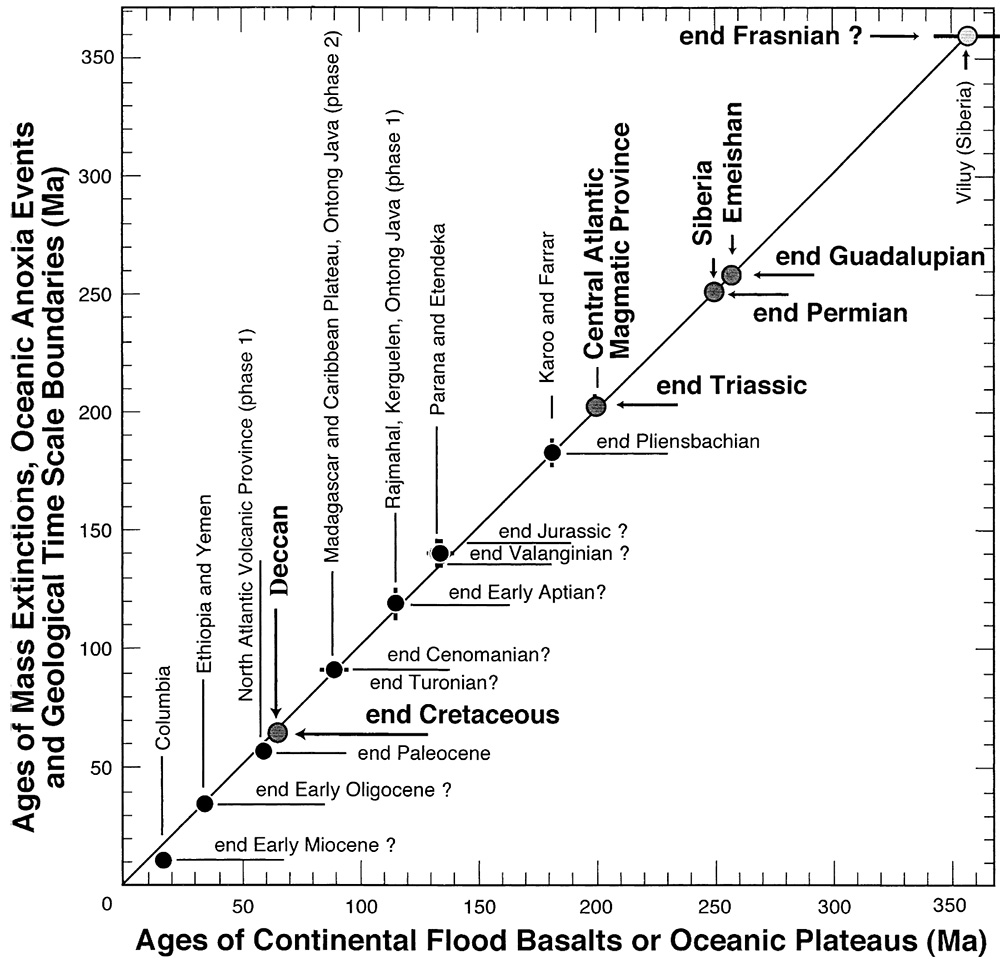
The most recent flood basalt was the Columbia River Basalts in Oregon and Washington States at approximately 16 million years ago with an estimated volume of 174,300 km3 (McBirney, 2007). A recurrence of even the smallest of these flood basalts would be a major problem for humankind.
The differences between explosive and effusive volcanism are summarized in THIS TABLE. Basalt is the primitive magma rising from the mantle into the crust. When the crust is thin, as in ocean plateaus and ocean basins, hot basalt has enough buoyancy to rise to form sills and small magma chambers at a few kilometers depth and then to extrude out onto the surface with the minor dissolved gas content forming lava fountains and curtains of fire. Explosions are typically too small to eject substantial volcanic ash and gases into the stratosphere. Extrusions are typically very voluminous, accumulating over weeks to millennia. When the crust is thick, basalt can only rise to depths of 5 to 15 km where its heat content melts crustal materials, forming more evolved silicic magmas. Over hundreds to hundreds-of-thousands of years, the density of the magma decreases and the gas content increases until some magma can rise to the surface causing a large explosive eruption. Sometimes so much magma is ejected in a giant eruption that the overlying crust drops down into the magma chamber forming a caldera. Explosive eruptions tend to last only hours to days but an individual volcano may erupt again over intervals of centuries to hundreds-of-thousands of years.
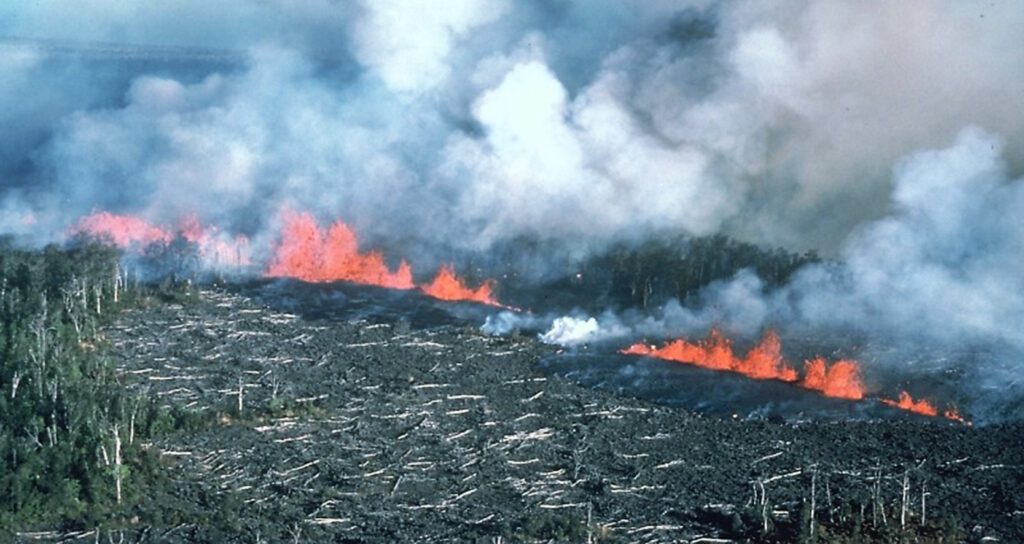
Approximately 80% of all volcanism on Earth occurs along mid-ocean ridges, most of which lie more than 2 km below sea-level. These volcanoes do not have much direct effect on climate, but they do heat the ocean. Kump et al. (2005) argue that massive release of hydrogen sulfide from submarine volcanoes during anoxic intervals of Earth history would cause ozone depletion and warming.
In summary, large explosive volcanic eruptions have been observed throughout human history to cause global cooling of up to 0.6oC for up to 3 years and can increment Earth into ice ages when occurring every decade or so Ice Ages. Voluminous effusive eruptions of basalt lasting months to hundreds-of-thousands of years have been contemporaneous with major global warming of many degrees centigrade during eruptive periods throughout both human and geologic history. The balance between how much explosive volcanism and how much effusive volcanism occurs at any time is determined by the motions of tectonic plates (Ward, 1995) (Ward, 2009) and has a dominant effect on climate because both types of volcanic eruptions deplete ozone.